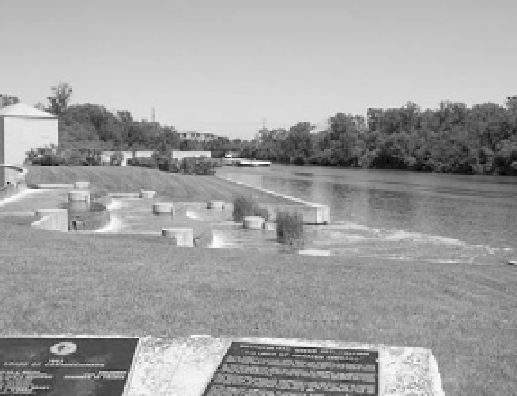Environmental Engineering Reference
In-Depth Information
The fact that DO concentrations in water can be significantly increased under pressurized conditions is
not disputable, however, what is questionable is how much of this supersaturated gas remains in solution
and remains usable upon exposure to normal atmospheric pressure (CTE, 2007). Shallow streams and
rivers may not be capable of absorbing oxygen before it comes into contact with air and becomes lost as
a gas into the atmosphere. Most applications of U-Tubes to date have been for deep water bodies
including lakes, reservoirs, and deep running rivers, such as those found below high head hydropower
dams. U-tubes have high capital costs and access for maintenance is difficult. However, compressed air
U-tubes require relatively low electrical energy.
Free Fall Weirs and Cascades
aerate water by rapid contact with the atmosphere on all sides as in a
natural waterfall. Water flowing over dam spillways and waterfalls commonly achieves saturation DO
concentrations in the course of falling through the atmosphere. The MWRDGC applied this principle on
a large scale when they installed 5 Sidestream Elevated Pool Aeration (SEPA) stations along the Calumet
River, Little Calumet River, and Calumet-Sag Channel on the south side of the Chicago area. The SEPA
stations work by using screw pumps to lift water from the source waterway. The water then passes through
a series of pools and over a cascade of weirs (see Fig. 9.16) through which DO concentrations at or even
slightly above saturation are achieved in the final outflow (Butts et al., 2000). The SEPA stations have
higher capital and operation and maintenance costs than ceramic diffusers and U-Tubes (CTE, 2007).
They also require access to a significant stretch of land parallel and adjacent to the waterway, and have
operational concerns, such as aquatic weed growth (see Fig. 9.16) and excessive sediment deposits in the
pools. However, they have many substantial aesthetic benefits such as creating attractive park like conditions
in the urban landscapes, such as the southern suburbs of Chicago.
Mobile (Barge-Mounted) Dispersion of Pure Oxygen
can achieve OTEs as high as 90%. Such oxygen
barges have been used in London and Shanghai (among other places) to combat transient events of low
DO concentrations. However, this method does not seem practical to combat chronic problems of low DO
concentrations.
Fig. 9.16
Sidestream Elevated Pool Aeration station number 5 discharging aerated water back to the Calumet-Sag Channel
(See color figure at the end of this topic)
9.3
Nutrient Effects
Nutrients are chemicals that are essential to the growth of living things, in this chapter the focus is on
aquatic plants including algae. The main plant nutrients are carbon, nitrogen, and phosphorus each of


Search WWH ::

Custom Search